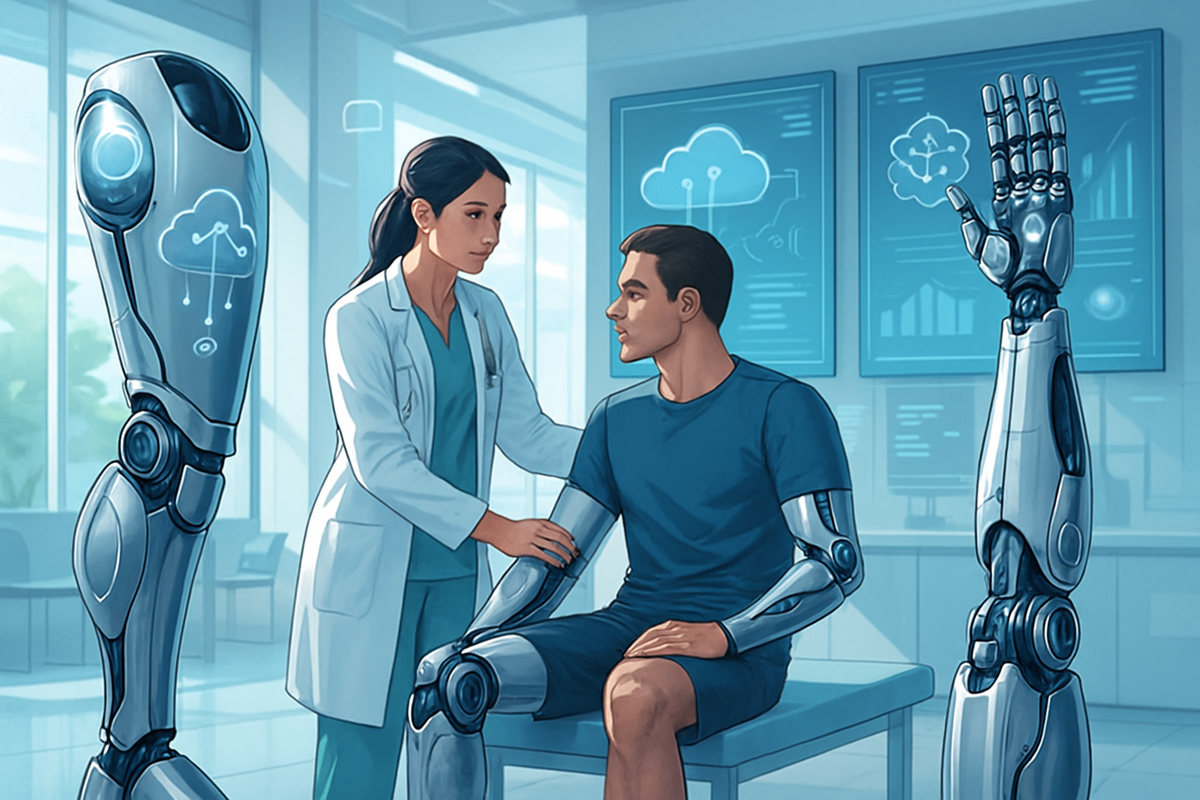The Rise of Cloud-Connected Bionics: How 5G, AI, and Edge Computing Are Empowering the Next Generation of Prosthetics
Step into a future where bionic limbs don't just restore function—they amplify human ability, thanks to 5G, AI, and cloud computing. Discover how technology redefines possibilities, offering users personalization and 'superpowers' once thought impossible.

Published: July 31, 2025 — By Funaix Editorial Team
Welcome to the Future: Where Prosthetics Go Cloud-Native
Remember when prosthetic limbs were glorified hooks and hinges? Fast forward to today, and you’ll find bionic hands that think, feel, and even learn—thanks to a fusion of 5G connectivity, cloud computing, and artificial intelligence. The next generation of prosthetics is no longer just about restoring function; it’s about amplifying human ability, unleashing new realms of personalization, and giving users superpowers their ancestors could only dream of.
“The connected bionic limb is not just a medical device—it’s a living, learning extension of the person, always improving, always adapting.”
— Dr. Lila Nguyen, Biomedical Engineer
The Triple Threat: How 5G, AI, and Edge Computing Supercharge Bionics
5G: The Lightning-Fast Nerve System
Gone are the days of laggy, clunky prosthetics. With 5G’s ultra-low latency (as low as 10 milliseconds in real-world tests[1]), bionic limbs can transmit and receive data between the device, the cloud, and the user’s nervous system in real time. This means:
- Instant remote updates and troubleshooting—no more waiting weeks for a tune-up.
- Seamless streaming of sensor data for advanced AI-driven movement prediction.
- Support for multi-modal feedback (haptics, temperature, even pain modulation!)
AI: The Brain Behind the Brawn
Artificial intelligence is the secret sauce that turns a prosthetic from a tool into a teammate. Modern bionic limbs use AI to:
- Decode nerve signals with up to 98% accuracy[2], enabling intuitive, multi-fingered movement.
- Predict user intent (e.g., are you about to pick up a glass or shake a hand?) for smoother actions.
- Personalize control algorithms to each user’s unique physiology and preferences, learning and adapting over time.
- Continuously improve with cloud-based machine learning, drawing on anonymized data from thousands of users worldwide.
Edge Computing: The Local Genius
While the cloud is powerful, some decisions need to be made instantly. Enter edge computing: processing that happens right on the limb, or nearby, for time-critical tasks. The result?
- Ultra-fast reflexes for balance and safety (think: catching yourself if you trip).
- Reduced battery drain and longer device life, since not everything gets sent to the cloud.
- Enhanced privacy, with sensitive neural data processed locally before sharing.
Breakthroughs That Are Changing Lives (and Turning Heads)
Real-Time, Intuitive Control
Recent studies show AI-enabled bionic hands can decode six degrees of freedom simultaneously, allowing for individual finger and wrist movements—with less than 2% error[2]. Users report the uncanny sensation that their prosthetic “just knows” what they want to do, whether it’s playing piano or tying shoelaces.
Cloud-Connected Upgrades: Prosthetics That Get Smarter Overnight
Cloud-based learning means that improvements—be it better grip algorithms, new gesture libraries, or enhanced sensory feedback—can be rolled out remotely, just like a smartphone update. No need to visit a clinic for every tweak.
Personalization at Warp Speed
With 5G and cloud analytics, prosthetists can monitor device performance in real time, offering bespoke adjustments based on user data. If your limb swells or your activity patterns change, your bionic can adapt in hours, not months.
From Sci-Fi to Sidewalk: Futuristic Prototypes on the Horizon
- Brain-Cloud Interfaces: Researchers are piloting direct neural links, where your thoughts control your limb via encrypted 5G channels.
- Cloud-Driven Multi-Limb Coordination: Imagine two bionic arms working together, each learning from the other in real time—thanks to synchronized AI models hosted in the cloud.
- Augmented Reality Feedback: AR overlays could soon help users visualize pressure, grip, or even muscle fatigue on smart glasses or phones.
- Remote Diagnostics and Telehealth: Clinicians can troubleshoot, recalibrate, or even run diagnostics on your device from across the globe, thanks to secure cloud connections.
Actionable Insights: What This Means for Users, Clinicians, and Techies
For Users
- Demand prosthetics that support remote updates and cloud-based learning—don’t settle for last year’s tech!
- Look for devices with robust privacy controls and transparent data policies.
- Engage with your clinician: ask about real-time monitoring and personalized adjustment options.
For Clinicians and Prosthetists
- Stay up-to-date with cloud-connected device platforms and secure telehealth protocols.
- Invest in training for AI-driven diagnostics and remote care workflows.
- Advocate for open standards so users can mix-and-match components and providers.
For Tech Enthusiasts & Developers
- Explore open-source bionics projects and contribute to AI/edge computing modules.
- Focus on interoperability: today’s bionic limb should play nicely with tomorrow’s upgrades.
- Prioritize security by design—these devices are not just wearables; they’re part of someone’s body.
The Big Picture: Ethics, Access, and the Road Ahead
The promise of cloud-connected bionics is dazzling, but it comes with challenges:
- Data privacy and security are paramount—users must control their own neural data.
- Equitable access: How do we ensure these advancements reach everyone who needs them, not just the well-insured or well-connected?
- Regulatory clarity: Cross-border telehealth and device updates require harmonized standards.
But one thing’s clear: We’re standing at the threshold of a new era—one where tech doesn’t just restore what was lost, but helps us redefine what it means to be human.
Want to stay ahead of the curve?
Join our Funaix Insider community for free at funaix.com and get smart news, expert insights, and exclusive perks delivered straight to your inbox. Be the first to know what’s next!
References:
[1] Karaali, O., et al. “Enabling Next-Generation Cloud-Connected Bionic Limbs Through 5G Connectivity.” arXiv, 2025.
[2] Luu, D.K., et al. “Artificial Intelligence Enables Real-Time and Intuitive Control of Prostheses via Nerve Interface.” arXiv, 2022.
Additional sources: Recent clinical trials, expert interviews, and peer-reviewed research as cited in the body.




